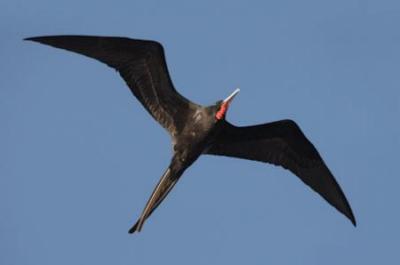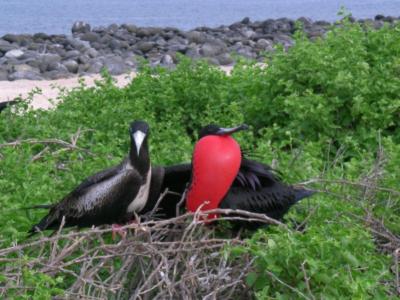 SKC Films Library SKC Films Library |
| |
| SKC Films Library
>> Science
>> Zoology >> Birds >> Order Pelecaniformes |
| Magnificent Frigatebird Fregata magnificens Description The magnificent frigatebird can be easily recognized in flight, even from a distance, thanks to its large head, long, pointed, narrow wings, and forked tail. If there is any doubt about the bird's identity, a view that includes the bright red gular sac and white bill (of the male) will confirm that it is a magnificent frigatebird.
Frigatebirds are the only seabirds to have obvious, significant differences in plumage between the sexes. Male magnificent frigatebirds are entirely black except for brown inner secondaries on the upper wing, faint purple gloss on the head, green on the neck, scapulars, and upper wing, and a red inflatable throat pouch (gular sac). Their legs and feet appear black or grayish. Females are also entirely black, but have a white chest and white and tan markings on the wings. Their legs and feet are flesh-colored or pink, and they lack a gular sac. Immature magnificent frigatebirds have a white head and chest while the rest of the body is black. Their legs, feet, and bill are light-bluish gray. Magnificent frigatebirds measure 35-45 inches in length, have a wingspan of 85-96 inches, and weigh 2.4-3.5 pounds. Females are, in general, 15% larger than males. Their wings are so large that flying is nearly effortless. They take advantage of updrafts and can glide for long distances without beating their wings. They use their long, forked tails for maneuvering. They are one of the only birds with the ability to ride out a hurricane's strong winds. Their short legs and small feet make them awkward on land, however. Moreover, the plumage lacks a waterproof coating, so the bird becomes waterlogged and cannot fly if it sits on the water for more than a minute or two. Distribution and Habitat The breeding range of the magnificent frigatebird includes islands throughout the Caribbean, tropical areas along the Pacific and Atlantic coasts of Middle and South America, and the Galapagos Islands. Outside the breeding season, this species' range is even more expansive, with individuals regularly found along the Pacific coast from central California, south to northern Peru, and along the Atlantic coast from North Carolina, south to northern Argentina. During storms, magnificent frigatebird individuals may be blown exceptionally long distances off course, and have been spotted as far north as Alaska and Canada, and as far east as the west coast of Africa, and even Great Britain, the Netherlands, and Denmark. This species breeds in stands of mangroves on coral reefs, and amongst deciduous trees and bushes on dry islands and along coasts. During breeding, foraging may take place over shallow water within lagoons and coral reefs, or over deep ocean. Outside the breeding season, it can usually be found over warm coastal and offshore waters, and roosts in trees on tropical and subtropical coasts and islands. Diet Magnificent frigatebirds feed primarily on fish, squid, jellyfish, and crustaceans, but the diet can vary greatly depending on availability and preferred hunting technique. The three main hunting techniques are dipping, kleptoparasitism, and opportunistic feeding. When dipping, the bird glides just above the water and skims the surface with its beak to catch fish. It can only dip about 6 inches deep, however, since it cannot allow its feathers to get too wet. Kleptoparasitism, the stealing of another animal's food, has earned this species the nickname "Man-'o-War," a reference to the type of ship used by pirates. The frigatebirds will chase another bird (usually a gulls gannet, tern, or booby) until the "victim" is forced to disgorge its food, which is caught in mid-air by the frigatebird. It may also catch the other bird by the tail feathers and shake it until it releases its food. Opportunistic feeding involves eating garbage, young turtles at hatching, and otherwise taking advantage of all available food sources. Magnificent frigatebirds eat fish scraps discarded by boats, offal (discarded parts of animals unfit for consumption) from slaughterhouses, and other garbage, and have even been knwon to steal food from the hands of humans. Reproduction During the breeding season, which runs from August to October, male magnificent frigatebirds congregate at display sites. They inflate their gular sacs, which, while inflated, can get so large that they obscure the bird's head, rapidly vibrate their wings, and sit back on their tails. Females then inspect the males. Magnificent frigatebirds form monogamous pairs each breeding season once females have selected mates, but rarely maintain the same partner from season to season. Once paired, the male gathers twigs and other nest-building materials while the female remains at the display site and builds the nest there. Nests are usually constructed at ground level, but are sometimes built in a low shrub or tree. The nest itself is flat or slightly hollow with a diameter of 9-14 inches. After mating, a single egg is laid, which is incubated for 53-61 days by both parent birds. The chick, which takes around 22 weeks to fledge, is brooded and fed by both sexes for the first 7-12 weeks, after which time the male leaves and the female assumes full responsibility for raising the chick, providing food until fully fledged, and then for a further 4-9 months. Because female parent involvement continues for much longer than male parental involvement, females only mate every other year, while males mate every year. Scientific Classification phylum Chordata SOURCES |
SKC Films Library >> Science >> Zoology >> Birds >> Order Pelecaniformes This page was last updated on April 05, 2017. |

